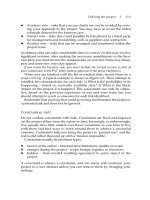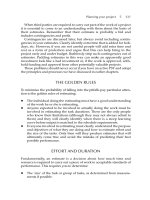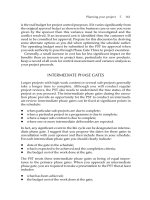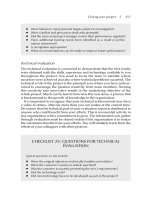Management a practical introduction 3rd kinicky chapter 12
Bạn đang xem bản rút gọn của tài liệu. Xem và tải ngay bản đầy đủ của tài liệu tại đây (769.08 KB, 50 trang )
Management
A Practical Introduction
Third Edition
Angelo Kinicki &
Brian K. Williams
Kinicki/Williams, Management: A Practical Introduction 3e ©2008, McGraw-Hill/Irwin
Chapter 12: Motivating Employees
Achieving Superior Performance
in the Workplace
Motivating for Performance
What Motivates Employees?
Do Rewards Work?
How Should Jobs Be Designed?
What Incentives Should Be Used
Does Compensation Motivate?
Kinicki/Williams, Management: A Practical Introduction 3e ©2008, McGraw-Hill/Irwin
2
12.1 Motivating For Performance
Motivation: may be defined as the psychological
processes that arouse and direct goal-directed
behavior.
McGraw-Hill/Irwin
Kinicki/Williams, Management: A Practical Introduction 3e ©2008, McGraw-Hill/Irwin
© 2006 The McGraw-Hill Companies, Inc. All rights rese
3
12.1 Motivating For Performance
WHAT IS MOTIVATION?
The psychological processes that arouse and direct
goal-directed behavior is motivation
In a simple model of motivation, people have needs
that motivate them to perform specific behaviors for
which they receive rewards that feed back and satisfy
the original needs
Rewards can be extrinsic (the payoff a person
receives from others for performing a particular task),
or intrinsic (the satisfaction a person receives from
performing the particular task itself)
Kinicki/Williams, Management: A Practical Introduction 3e ©2008, McGraw-Hill/Irwin
4
Intrinsic vs. Extrinsic Rewards
Extrinsic =
Outside
Recognitio
n
Promotion
s
Gifts
Intrinsic =
Inside
Feeling of
Job Well
Prid
Done
e
Sense of
Achieveme
nt
Praise
Salary
Increase
Status
Kinicki/Williams, Management: A Practical Introduction 3e ©2008, McGraw-Hill/Irwin
5
12.1 Motivating For Performance
Figure 12.1: A Simple Model Of Motivation
Kinicki/Williams, Management: A Practical Introduction 3e ©2008, McGraw-Hill/Irwin
6
12.1 Motivating For Performance
WHY IS MOTIVATION IMPORTANT?
It is important to motivate people to
-join your organization
-stay with your organization
-show up for work at your organization
-perform better for your organization
-do extra for your organization
Kinicki/Williams, Management: A Practical Introduction 3e ©2008, McGraw-Hill/Irwin
7
12.2 Content Perspectives
On Employee Motivation
WHAT KINDS OF NEEDS MOTIVATE
EMPLOYEES?
Theories that emphasize the needs that motivate people are
content perspectives or need-based perspectives
-where needs are defined as physiological or psychological
deficiencies that arouse behavior
Three content perspectives are Maslow’s hierarchy of
needs, McClelland’s acquired needs theory, and Herzberg’s
two-factor theory
Kinicki/Williams, Management: A Practical Introduction 3e ©2008, McGraw-Hill/Irwin
8
12.2 Content Perspectives
On Employee Motivation
1. Abraham Maslow put forth the hierarchy of needs theory
which proposes that people are motivated by five levels of
needs:
At the most basic level, people try to fulfill physiological
needs (basic human needs like food, clothing, and shelter)
Next, are safety needs (physical safety, emotional security,
avoidance of violence)
Then, belongingness needs (love, friendship, affection)
Next, esteem needs (self-respect, status, reputation,
recognition, and self-confidence)
Finally, self-actualization needs (self-fulfillment increasing
competence, using abilities to the fullest)
Kinicki/Williams, Management: A Practical Introduction 3e ©2008, McGraw-Hill/Irwin
9
12.2 Content Perspectives
On Employee Motivation
Figure 12.2: Maslow’s Hierarchy of Needs
Kinicki/Williams, Management: A Practical Introduction 3e ©2008, McGraw-Hill/Irwin
10
Maslow’s Hierarchy of Needs: What the
Organization Can Do
5. SelfOffer adequate ventilation, heat,
actualization
water, base pay
needs
5. Selfactualization
needs
4. Esteem Needs
3. Belongingness Needs
2. Safety Needs
1. Physiological Needs
McGraw-Hill/Irwin
Kinicki/Williams, Management: A Practical Introduction 3e ©2008, McGraw-Hill/Irwin
© 2006 The McGraw-Hill Companies, Inc. All rights rese
11
Maslow’s Hierarchy of Needs: What the
Organization Can Do (Cont.)
5. Selfactualization
needs
Offer safe working conditions, job
security, health and retirement
benefits
4. Esteem Needs
3. Belongingness Needs
2. Safety Needs
1. Physiological Needs
McGraw-Hill/Irwin
Kinicki/Williams, Management: A Practical Introduction 3e ©2008, McGraw-Hill/Irwin
© 2006 The McGraw-Hill Companies, Inc. All rights rese
12
Maslow’s Hierarchy of Needs: What the
Organization Can Do (Cont.)
Offer interaction with others,
participation in workgroup, good5. Selfrelations with supervisors actualization
needs
5. Selfactualization
needs
4. Esteem Needs
3. Belongingness Needs
2. Safety Needs
1. Physiological Needs
McGraw-Hill/Irwin
Kinicki/Williams, Management: A Practical Introduction 3e ©2008, McGraw-Hill/Irwin
© 2006 The McGraw-Hill Companies, Inc. All rights rese
13
Maslow’s Hierarchy of Needs: What the
Organization Can Do (Cont.)
Offer recognition, status,
challenges, merit pay, employee
participation in making decisions
5. Selfactualization
needs
4. Esteem Needs
3. Belongingness Needs
2. Safety Needs
1. Physiological Needs
McGraw-Hill/Irwin
Kinicki/Williams, Management: A Practical Introduction 3e ©2008, McGraw-Hill/Irwin
© 2006 The McGraw-Hill Companies, Inc. All rights rese
14
Maslow’s Hierarchy of Needs: What the
Organization Can Do (Cont.)
Offer training, creativity,
promotions, employee control
over jobs
5. Selfactualization
needs
5. Selfactualization
needs
4. Esteem Needs
3. Belongingness Needs
2. Safety Needs
1. Physiological Needs
McGraw-Hill/Irwin
Kinicki/Williams, Management: A Practical Introduction 3e ©2008, McGraw-Hill/Irwin
© 2006 The McGraw-Hill Companies, Inc. All rights rese
15
Rules of Maslow’s Hierarchy of Needs
Unsatisfied
SelfActualizati
on
Esteem
Needs
Social Needs
(Belongingness)
Safety Needs
Physiological
Needs
Kinicki/Williams, Management: A Practical Introduction 3e ©2008, McGraw-Hill/Irwin
16
Satisfie
d
Chapter 12: Motivating Employees
CLASSROOM PERFORMANCE SYSTEM
Which of the following is not one of Maslow’s needs?
A) psychological needs
B) esteem needs
C) self-actualization needs
D) safety needs
Kinicki/Williams, Management: A Practical Introduction 3e ©2008, McGraw-Hill/Irwin
17
Chapter 12: Motivating Employees
CLASSROOM PERFORMANCE SYSTEM
Love, friendship, and affect needs are part of which
of Maslow’s five needs?
A) belongingness needs
B) esteem needs
C) self-actualization needs
D) safety needs
Kinicki/Williams, Management: A Practical Introduction 3e ©2008, McGraw-Hill/Irwin
18
12.2 Content Perspectives
On Employee Motivation
2. David McClelland proposed the acquired needs theory
which argues that three needs (achievement, power, and
affiliation) are major motivators in the workplace
The three needs are associated with different sets of work
preferences
People with a high need for achievement excel in technical
fields that require creativity and individual skills
People who have a high need for power will do well in jobs
where they can control others and be publicly applauded for
their accomplishments
People with a high need for affiliation prefer work where
personal relationships and social approval are important
Kinicki/Williams, Management: A Practical Introduction 3e ©2008, McGraw-Hill/Irwin
19
Needs Theories: McClelland
Acquired Needs Theory: states that three needs are
major motives determining people’s behavior in the
workplace:
Need for achievement – desire to excel
Need for affiliation – desire for friendly relations with
other people
Need for power – desire to be responsible for other
people, to influence their behavior, or to control them
Negative power – personal power
Positive power – institutional power
McGraw-Hill/Irwin
Kinicki/Williams, Management: A Practical Introduction 3e ©2008, McGraw-Hill/Irwin
© 2006 The McGraw-Hill Companies, Inc. All rights rese
20
McClelland’s Three Needs
Achievement Affiliation
5. “well-balanced
SelfA
individual”
actualization
needs
Power
Achievement Affiliation
A “control freak”
McGraw-Hill/Irwin
Power
Kinicki/Williams, Management: A Practical Introduction 3e ©2008, McGraw-Hill/Irwin
© 2006 The McGraw-Hill Companies, Inc. All rights rese
21
12.2 Content Perspectives
On Employee Motivation
3. Frederick Hertzberg proposed that work
satisfaction and dissatisfaction arise from two
different factors:
Lower level needs are usually handled through
hygiene factors (factors associated with job
dissatisfaction like salary and working conditions)
Higher level needs are associated with motivating
factors (factors associated with job satisfaction)
So, managers should eliminate dissatisfaction, then
focus on encouraging motivation
Kinicki/Williams, Management: A Practical Introduction 3e ©2008, McGraw-Hill/Irwin
22
Herzberg’s Two-Factor Concept
•
•
•
•
•
•
Job-Related
Job Environment
(Motivators)
(Hygiene Factors)
Achievement
Recognition
Work Itself
Growth/Advancement
Responsibility
Peer Relationships
• Working Conditions
• Salary
• Policy &
Administration
• Supervision
Kinicki/Williams, Management: A Practical Introduction 3e ©2008, McGraw-Hill/Irwin
23
12.2 Content Perspectives
On Employee Motivation
Figure 12.4:
Hertzberg’s TwoFactor Theory:
Satisfaction Versus
Dissatisfaction
Kinicki/Williams, Management: A Practical Introduction 3e ©2008, McGraw-Hill/Irwin
24
A Comparison of Needs Theories:
Maslow, Herzberg, and McClelland
Maslow
Higher
level
needs
Lower
level
needs
McGraw-Hill/Irwin
Self-actualization
Herzberg
5.
Selfactualization
needs
Motivating factors
McClelland
Achievement
Esteem
Power
Belongingness
Affiliation
Safety
Physiological
Hygiene factors
Kinicki/Williams, Management: A Practical Introduction 3e ©2008, McGraw-Hill/Irwin
© 2006 The McGraw-Hill Companies, Inc. All rights rese
25









